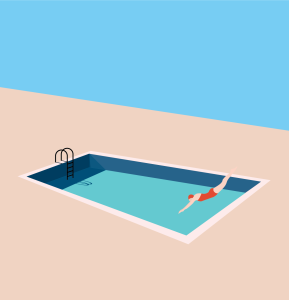Can I swim after getting a piercing?
Thinking of swimming with a new piercing? But wait… can you? Good thing you’ve asked, we’re happy to help!
2 Weeks Post Piercing
We recommend to avoid swimming for the first two weeks after a piercing.
If you must swim, we recommend covering your piercing with a waterproof Band-Aid. Always spray with Sterilear Step 1: Clean after swimming and removing the Band-Aid. Spray sparingly, and rinse after use.
Piercings heal on the outside first and then on the inside. This means a piercing may look healed, when actually, it is not. It is important to refer to our aftercare information to ensure the best healing process.
Click here to read our full piercing aftercare instructions
For piercings to heal it is important that the area remains clean and dry. Swimming may surround the opening of the piercing with bacteria. This may cause infection, through the opening in your skin.
Pools:
Many people assume swimming in a chlorine pool won’t cause bacterial infections. However, chlorine does not kill germs and bacteria immediately. Germs can survive in a chlorinated pool for days, and infect your piercing.
Children’s ear piercings can be very sensitive in the healing period. We understand the importance of upkeeping your child’s swimming lessons,. Make sure to use the Band-Aid and aftercare recommendations after entering water.

Streams, lakes and the ocean:
There are many bacterial types in all types of water; streams, lakes and the ocean. These bacteria’s can enter the piercing and cause infection. Infections in your piercing can look like sensitivity, swelling, redness and pain.

Swimming in stagnant water such as a lake, or dam can contribute to contracting infectious microorganisms.

Week 3 Post Piercing
Depending on what piercing you have and your body, the healing process will be different!
At this stage you should start using Sterilear Step 2: Care Piercing Spray. After 3 weeks, your earlobe piercing should be fine to swim, but upkeep our spray after each time in the water. Keep an eye on it, to monitor for any infections!
For other ear, facial and body piercings – play it by ear and if you have any questions reach out to your local salon. After the 3 week period, your piercing should be fine to swim too. Remember to spray after each time in water, and use a waterproof Band-Aid if you’re unsure.
Piercings are quite popular in the winter months, to have time to heal ready for summer. No one wants to miss out on that pool party, or beach day – so winter is a great time for piercings (especially belly)!
In summary… you should definitely get that new piercing! Remember to stay out of the water until your piercing has been healing for two weeks and always follow the aftercare advice. If you do need to swim in the first two weeks, use a Band-Aid and our spray. Speak to a Piercing Specialist in salon for advice, or if you have any questions.

